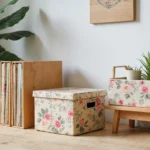We’ve all been there – opening our linen closet only to have sheets tumble out like an avalanche while we desperately search for matching pillowcases. A disorganized linen closet doesn’t just waste time; it creates daily frustration and makes even simple tasks feel overwhelming.
The good news? Transforming your chaotic linen storage into an organized oasis is easier than you think. With the right strategies and a few clever organizational tools you can create a system that actually works for your lifestyle. Whether you’re dealing with a tiny hall closet or a spacious walk-in we’ve got answers that’ll make every inch count.
Our proven linen closet organization ideas will help you maximize space create easy-to-maintain systems and finally achieve that Pinterest-worthy closet you’ve been dreaming about. Let’s turn your linen storage nightmare into a streamlined sanctuary that saves you time and reduces stress every single day.
Declutter Your Linen Closet Before Organizing
Successful linen closet organization starts with a thorough decluttering process. We must clear out unnecessary items before implementing any storage answers to create an efficient system that works long term.
Remove Everything and Sort Items
Empty your entire linen closet to see exactly what you’re working with and assess the available space. Pull out every sheet set, towel, washcloth, pillowcase, and miscellaneous item from each shelf and drawer.
Create designated sorting areas on your bed or a large table using different sections for various categories. We recommend establishing piles for bed linens, bath towels, hand towels, washcloths, table linens, and seasonal items like blankets or comforters.
Group similar items together to identify duplicates and determine which pieces you actually use regularly. Sort bed linens by size (twin, full, queen, king) and bath towels by type (bath sheets, standard bath towels, hand towels) to streamline your inventory process.
Check for matching sets and separate orphaned pieces that no longer have complete partners. Singles sheets without pillowcases or lone pillowcases can be repurposed as cleaning rags or moved to a different storage area.
Donate or Discard Worn-Out Linens
Inspect each item carefully for signs of wear like holes, permanent stains, fraying edges, or fabric that feels rough after repeated washing. We find that linens showing these signs rarely improve with continued use and take up valuable storage space.
Apply the one year rule to items you haven’t used in the past 12 months, as these pieces likely won’t return to regular rotation. Donate linens in good condition to local shelters, animal rescue organizations, or charitable thrift stores where they’ll serve others better.
Repurpose damaged linens that aren’t suitable for donation into useful household items like cleaning rags, drop cloths for painting projects, or pet bedding. Cut worn sheets and towels into smaller squares for garage work or dusting tasks.
Keep only what you need by maintaining a reasonable quantity for each household member plus one extra set for guests. Most families function well with two to three sheet sets per bed and four to six towels per person.
Check Expiration Dates on Toiletries
Examine all toiletries and medications stored in your linen closet for expiration dates, as expired products lose effectiveness and may cause skin irritation. We often discover forgotten bottles of lotion, tubes of toothpaste, and over the counter medications that passed their prime months ago.
Remove expired sunscreen immediately since it provides inadequate UV protection after its expiration date and could lead to serious burns. Expired sunscreen also changes texture and may separate or develop an unpleasant odor.
Discard old makeup and skincare products that have been open for extended periods, as bacteria growth becomes a concern after manufacturer recommended timeframes. Foundation and concealer typically last 12 months, while mascara should be replaced every three months.
Dispose of medications properly by taking them to pharmacy take back programs or following FDA guidelines for safe disposal at home. Never flush medications down the toilet or throw them in regular trash where children or pets might access them.
Maximize Vertical Space with Shelving Solutions
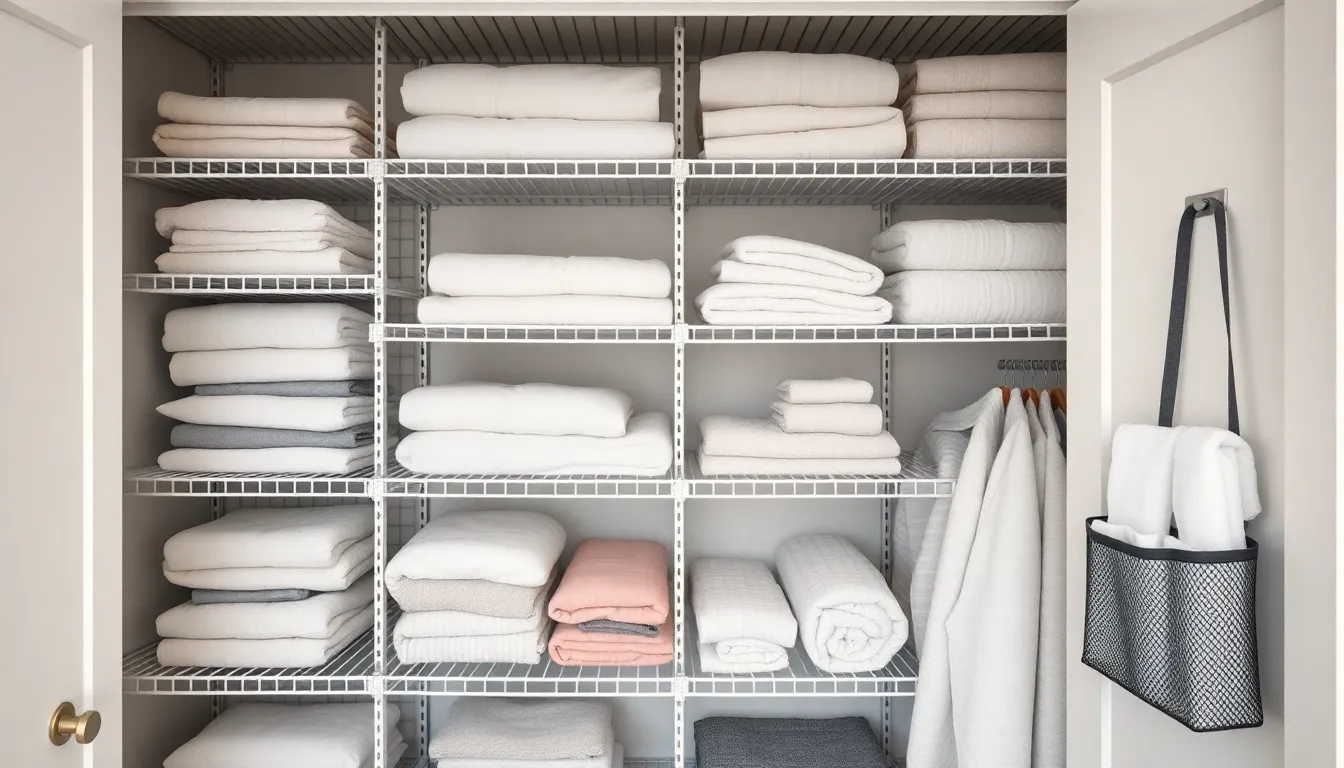
After decluttering our linen closet, we can transform the available vertical space into highly functional storage. Installing additional shelves or using under-shelf baskets increases usable space and helps separate linens by type, making items easier to find and access.
Install Adjustable Wire Shelving
Adjustable wire shelving gives us flexible spacing between shelves, accommodating different sizes of folded linens, blankets, or pillows. This system makes it simple to reconfigure our closet as storage needs change throughout the year. Wire shelving supports heavy loads while improving air circulation around stored items, preventing musty odors from developing. We’ll find that the durability of wire systems outlasts many other shelving options, making them a smart long-term investment for our linen organization.
Add Stackable Shelf Dividers
Shelf dividers keep our stacks of linens neat and prevent toppling when we remove items from the middle of a pile. These dividers create defined sections for each linen type, such as sheets, towels, or tablecloths, streamlining retrieval and replacement. Standalone dividers can be customized to fit our shelf width and height, while stackable options grow with our storage needs. We can quickly identify matching sets when dividers separate our bedding by size or color, eliminating the frustration of searching through mixed piles.
Use Over-the-Door Organizers
Over-the-door organizers provide extra storage for small or frequently used items like washcloths, napkins, or cleaning supplies without taking up valuable shelf space. Hanging pockets or hooks behind the door make use of otherwise unused space and improve accessibility to everyday essentials. These organizers free up room for larger linens on our main shelves while keeping smaller items visible and within easy reach. We’ll appreciate having quick access to items we use daily without disturbing our neatly folded linen stacks.
Create Designated Zones for Different Items
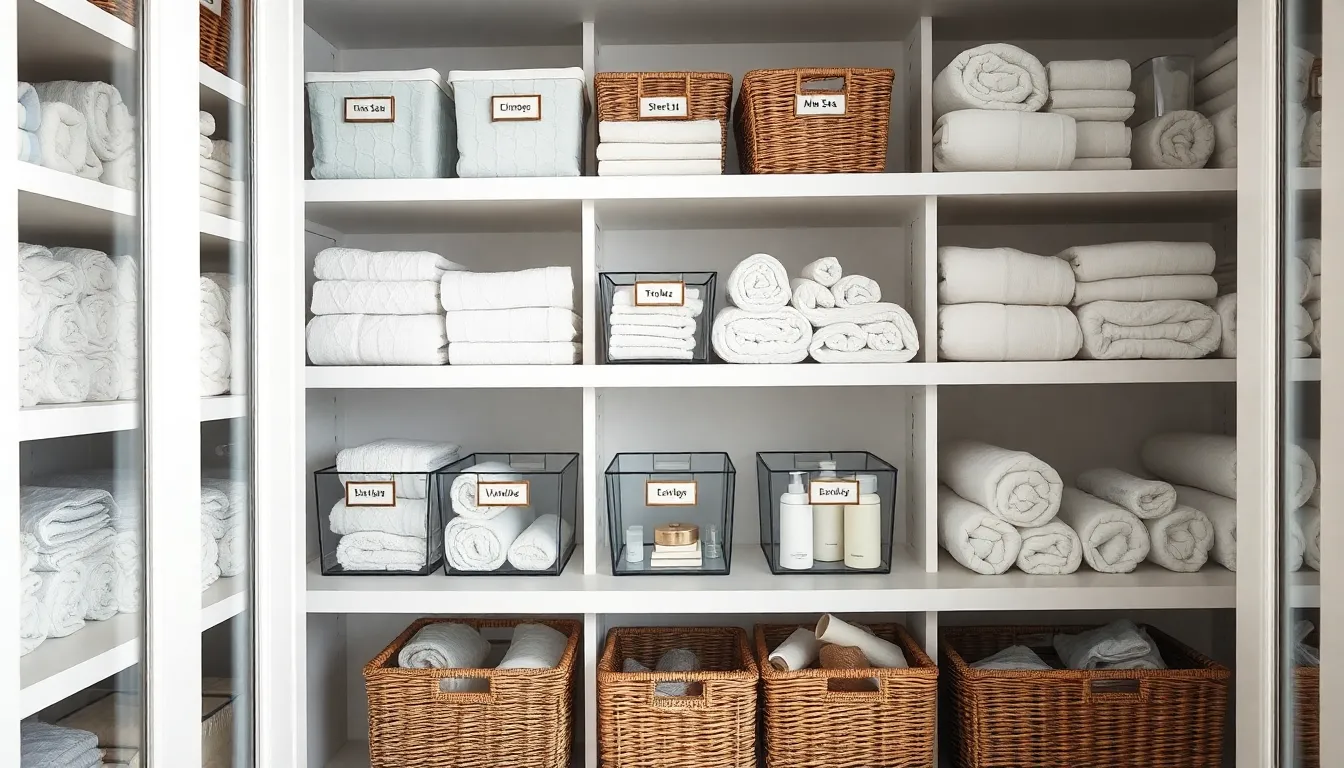
Establishing distinct zones within your linen closet transforms chaotic storage into an organized system that saves time and reduces frustration. We’ll create three primary zones that accommodate your most essential items while maintaining easy access and visual clarity.
Establish a Towel Section
Towel storage bins work perfectly for keeping bath towels, hand towels, and washcloths organized by size and frequency of use. Place labeled bins on lower shelves where family members can easily reach them without disrupting other items. Stack folded towels vertically within bins so you can see each towel’s color and grab what you need without unfolding the entire stack.
Towel shelves should occupy the most accessible area of your closet since towels get used daily. Dedicate one complete shelf to towel storage and use shelf dividers to separate bath towels from hand towels and washcloths. Roll towels instead of folding them to save 30% more space while creating a spa-like appearance that makes selection effortless.
Designate Space for Sheet Sets
Sheet boxes eliminate the frustration of searching through mixed piles when you need fresh bedding. Use clear storage boxes with labels indicating bed size and thread count to store complete sheet sets together. Keep one set on the bed, one set in the wash, and one set stored in your designated sheet box for optimal rotation.
Shelf dividers create boundaries that prevent sheet stacks from toppling over and mixing together. Install adjustable dividers on your sheet shelf to separate sets by bed size, with twin sets on one side and queen or king sets on the other. Store the fitted sheet, flat sheet, and one pillowcase inside the matching pillowcase to create a neat bundle that won’t separate.
Create a Toiletries and Bathroom Essentials Area
Toiletry baskets maximize vertical space while keeping small items contained and accessible. Use shallow baskets or small drawers on upper shelves for backup toiletries like toothpaste, shampoo, and soap refills. Label each basket by category so family members know exactly where to find replacements and where to return items.
Bathroom essentials shelf should house your most frequently needed items like extra toilet paper, cleaning supplies, and first aid materials. Position this shelf at eye level for easy inventory checks and quick access during busy mornings. Use stackable bins to separate cleaning supplies from personal care items, and keep a small basket for items that need to be restocked soon.
Implement Smart Storage Containers and Baskets

Storage answers transform cluttered linen closets into organized spaces that actually work for your daily routines. We’ve found that the right containers and baskets make all the difference in maintaining order while keeping items easily accessible.
Choose Clear Bins for Easy Visibility
Clear storage bins let us see exactly what’s inside without opening every container. We recommend using these transparent answers for toilet paper storage and extra toiletries since visibility helps us quickly identify what we need. This approach eliminates the guesswork that comes with opaque containers and saves precious time during busy mornings.
Wire baskets work exceptionally well on deep shelves where items might otherwise get lost in the back. We can easily spot hand towels and small bathroom essentials when they’re stored in clear or wire containers. These answers are particularly valuable in small linen closets where maximizing accessibility becomes crucial for daily functionality.
Use Fabric Baskets for Soft Items
Fabric containers excel at storing bedding sets because they’re gentle on delicate linens. We suggest dedicating separate fabric baskets for flat sheets, fitted sheets, and pillowcases to keep complete sets together. This method makes bed making effortless since everything we need stays in one designated container.
Soft-sided baskets prevent snagging on delicate fabrics while providing flexible storage that adapts to different linen sizes. We find these containers particularly useful for seasonal bedding that might vary in thickness throughout the year. The fabric material also adds a softer aesthetic to the closet space compared to hard plastic alternatives.
Label All Containers for Quick Identification
Labels ensure that our organizational system stays intact over time and helps other household members maintain the same standards. We recommend using clear, readable labels on every storage container to eliminate confusion about where items belong. This simple step prevents the gradual decline that happens when family members can’t figure out our system.
Consistent labeling makes restocking and retrieval remarkably faster during busy periods. We suggest using a label maker or waterproof labels that won’t peel off with humidity exposure. This investment in proper labeling pays dividends by maintaining the organized state we worked hard to achieve.
Fold and Store Linens Using Space-Saving Techniques
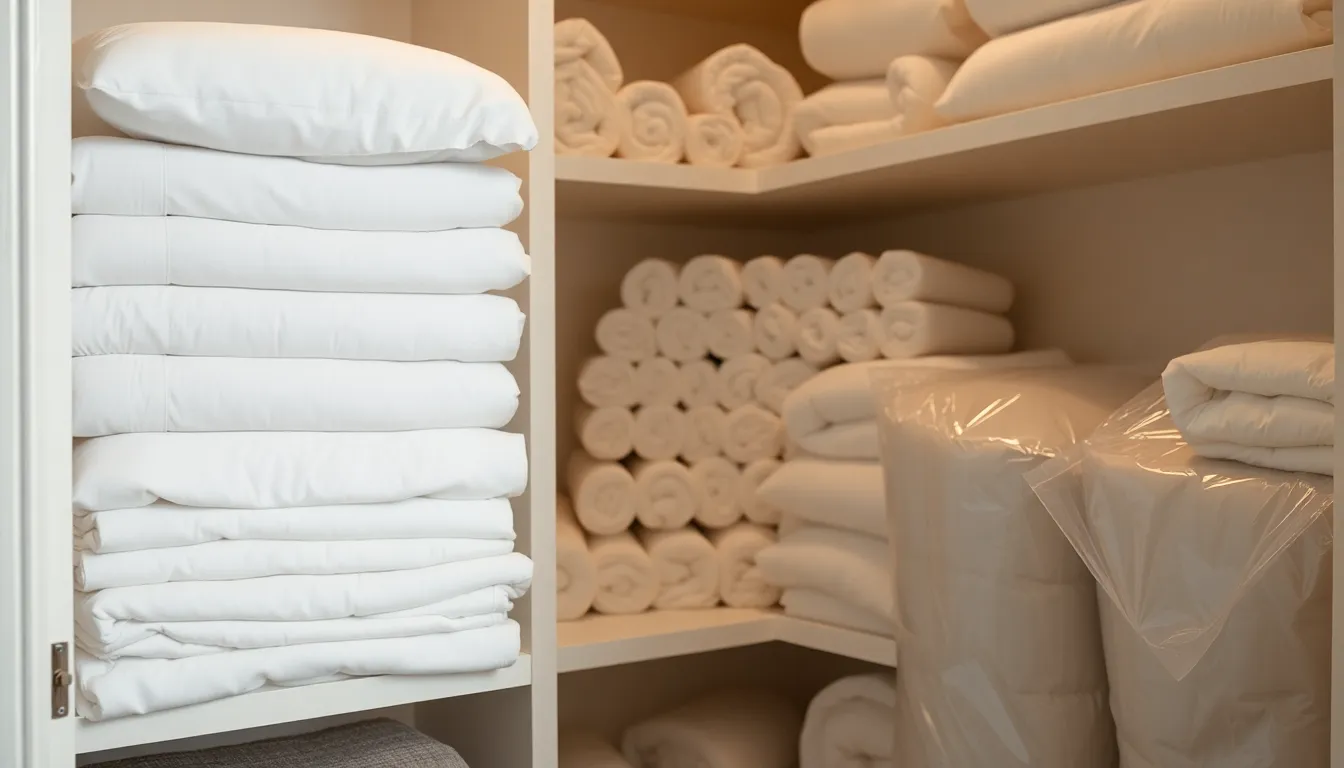
Effective folding techniques transform our linen closet from a chaotic mess into a streamlined storage system. Smart folding methods maximize every inch of available space while keeping our linens easily accessible.
Master the Sheet Set Folding Method
Keeping complete sheet sets together eliminates the frustration of searching for matching pieces when we need to change bedding. We recommend folding each component of the set separately, then tucking the fitted sheet, flat sheet, and one pillowcase inside the matching pillowcase to create a compact bundle. This method ensures we’ll always grab a complete set without hunting through multiple stacks.
Alternatively, we can place all folded components in a labeled container if we prefer a more structured approach. Container storage works particularly well for delicate fabrics or sets we don’t use frequently, providing extra protection while maintaining organization.
Roll Towels Instead of Folding
Rolling towels creates a uniform, space-efficient storage solution that allows us to fit more items on each shelf. This technique produces compact, cylindrical shapes that stack easily and provide visual appeal in our linen closet. We can see each towel clearly without disrupting entire stacks, making selection quick and maintaining order.
Rolling works especially well in smaller closets where every inch counts. The uniform appearance creates a spa-like aesthetic while maximizing our storage capacity, and accessing individual towels becomes effortless since we won’t need to lift heavy stacks.
Store Comforters in Vacuum-Sealed Bags
Bulky comforters and seasonal bedding consume enormous amounts of closet space when stored traditionally. Vacuum-sealed bags remove excess air and significantly reduce the volume of these items, freeing up valuable real estate in our linen closet. We can compress comforters to a fraction of their original size, making storage management much more efficient.
These bags work best for items we don’t access frequently, so we should store them on top shelves or in less convenient areas. The space savings allow us to dedicate prime closet real estate to everyday essentials while keeping seasonal items organized and protected.
Utilize Door Space for Additional Storage
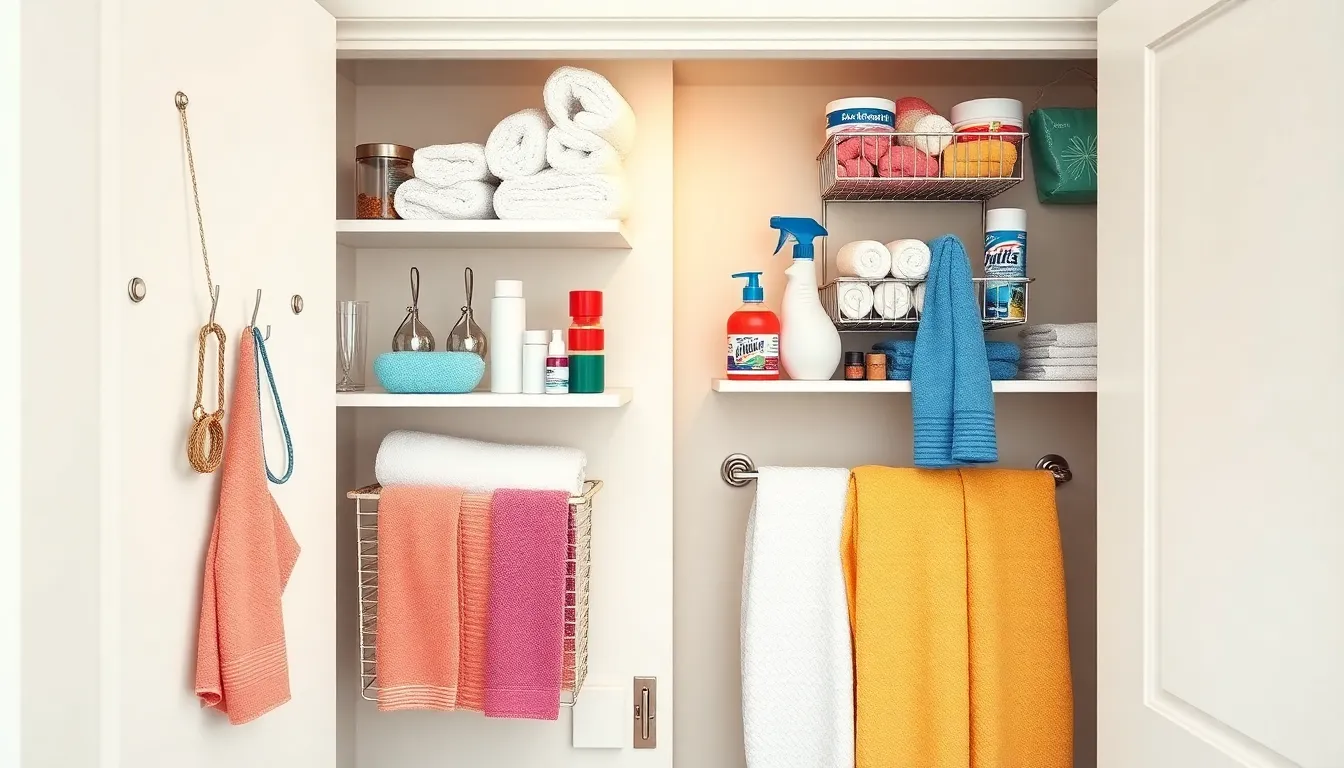
We often overlook our linen closet doors as valuable storage real estate. Empty door space offers multiple opportunities to maximize storage while keeping essential items within easy reach.
Install Hooks for Frequently Used Items
Adding hooks inside the closet or on the door transforms unused space into accessible storage for daily essentials. We can hang frequently used towels, robes, or air fresheners on these hooks, which immediately frees up shelf space for bulkier linens. Installing simple adhesive hooks or screw-in varieties provides spots for washcloths, hand towels, or even cleaning supplies that we reach for regularly. This strategic placement makes our most-used items more accessible while preventing them from cluttering valuable shelf real estate.
Add Slim Organizers Behind the Door
Slim over-the-door organizers and bins fit perfectly behind closet doors, utilizing otherwise wasted space for essential storage. We can store travel toiletries, extra toilet paper, or cleaning supplies in these narrow compartments without sacrificing shelf space. These organizers work particularly well for small items that tend to get lost on deep shelves, keeping everything visible and organized. Installing clear vinyl pouches or mesh organizers allows us to see contents at a peek while maintaining easy access to backup supplies and grooming tools.
Mount a Towel Bar on the Inside of the Door
Installing a towel bar on the inside of the door creates dedicated hanging space for hand towels, washcloths, or bathrobes. This placement keeps towels off shelves while facilitating better air circulation around stored linens. We can mount single or double towel bars depending on our needs, providing quick access to daily-use items without disrupting our organized shelf system. The towel bar solution works especially well for guest bathrooms where we want to keep fresh towels readily available for visitors.
Maintain Organization with Regular Cleaning Schedules

Keeping your linen closet organized requires consistent maintenance beyond the initial setup. Regular cleaning schedules prevent clutter from building up and ensure your linens stay fresh and accessible.
Establish a Monthly Inventory System
Monthly inventory checks help us track stock levels and prevent overbuying essentials. We recommend removing all items from one section at a time to assess what we have and what we need. During these checks, we should examine each item for wear and tear, removing anything that’s damaged or no longer useful.
Creating a simple checklist makes this process more efficient. We can note which items need replacement soon and update our shopping lists accordingly. This systematic approach prevents the accumulation of unused linens and helps us maintain order throughout the closet.
Taking photos of well-organized sections can serve as reference points for future organization efforts. We’ll know exactly how items should be arranged and can quickly restore order if things get messy.
Rotate Seasonal Items Regularly
Seasonal rotation keeps our most-needed linens within easy reach while maximizing closet space. We should move heavier blankets and comforters to higher shelves or storage containers during warmer months. Lighter throws and summer bedding can take their place in the prime real estate areas.
Clear labeling makes seasonal transitions smoother and faster. We can mark containers with exact seasons or temperature ranges to eliminate guesswork later. This system works particularly well when we store off-season items in clearly marked bins or vacuum-sealed bags.
Timing these rotations with our regular cleaning schedule creates an efficient routine. We’ll naturally assess seasonal needs while maintaining overall closet cleanliness and organization.
Keep a Running List of Items to Replace
Maintaining an ongoing replacement list prevents last-minute shopping trips and ensures we always have adequate supplies. We should update this list during our monthly inventory checks and regular cleaning sessions. Items that are worn out, stained beyond repair, or missing from sets belong on this list.
Keeping the list in a visible location helps us remember what we need during shopping trips. We can use a small notepad attached to the closet door or maintain a digital list on our phones. This approach prevents duplicate purchases and helps us budget for necessary replacements.
Tracking replacement needs also helps us identify patterns in our linen usage. We might discover that certain brands or materials last longer than others, informing our future purchasing decisions.
Conclusion
Creating an organized linen closet isn’t just about aesthetics—it’s about transforming your daily routine and eliminating the stress of searching through cluttered shelves. With these strategic organization methods you’ll save time every morning and evening while maintaining a space that truly works for your household.
The key to long-term success lies in choosing systems that fit your lifestyle and staying consistent with your maintenance routine. Whether you’re implementing vertical storage answers or establishing designated zones remember that small changes lead to important improvements over time.
Start with one section today and build momentum as you see the immediate benefits. Your future self will thank you every time you effortlessly locate the perfect towel set or fresh sheets without the usual frustration.
Frequently Asked Questions
How do I start organizing my linen closet?
Begin by completely emptying your linen closet to assess the available space. Sort all items into categories like bed linens, bath towels, and seasonal items. Group similar items together, check for matching sets, and separate orphaned pieces. Donate or discard worn-out linens and apply the one-year rule to unused items. Don’t forget to check expiration dates on toiletries and medications, disposing of expired products properly.
What’s the best way to maximize vertical space in my linen closet?
Install additional shelves or use under-shelf baskets to increase usable space. Adjustable wire shelving offers flexibility and durability while improving air circulation to prevent musty odors. Use stackable shelf dividers to keep linen stacks neat and organized. Consider over-the-door organizers for small or frequently used items, which frees up valuable shelf space while maintaining easy accessibility.
How should I organize different types of linens?
Create designated zones within your closet. Establish a towel section with labeled bins, stack towels vertically to save space, and dedicate specific shelves for towels. For sheet sets, use clear storage boxes with labels to keep complete sets together. Create a separate area for toiletries and bathroom essentials using labeled baskets, ensuring everything remains easily accessible and organized.
What storage containers work best for linen closets?
Use clear bins for easy visibility, especially for items like toilet paper and toiletries. Wire baskets work well for deep shelves to prevent items from getting lost in the back. Fabric baskets are ideal for storing delicate bedding sets. Always label all containers to maintain your organizational system over time, making it easier for household members to find and return items properly.
What are the most effective folding techniques for linens?
Master the sheet set folding method by folding each component separately and tucking them into a pillowcase for easy access to complete sets. Try rolling towels instead of folding them for space-efficient, visually appealing storage. Use vacuum-sealed bags for bulky comforters and seasonal bedding to significantly reduce their volume and free up valuable closet space.
How can I use door space for additional storage?
Install hooks inside the closet or on the door for frequently used items like towels and cleaning supplies. Use slim over-the-door organizers and bins for small items such as travel toiletries and extra toilet paper. Mount a towel bar on the inside of the door for hand towels and bathrobes, which improves air circulation and keeps items easily accessible.
How do I maintain my organized linen closet?
Establish a regular cleaning schedule to prevent clutter and keep linens fresh. Create a monthly inventory system to track stock levels and assess wear and tear. Implement seasonal rotation by moving heavier items to higher shelves during warmer months. Keep a running list of items that need replacement to avoid last-minute shopping trips and ensure you always have adequate supplies.

















